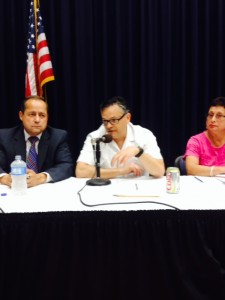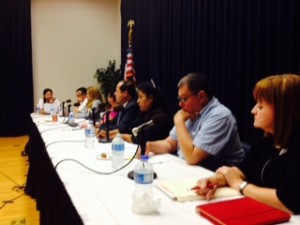by Radio Bilingüe News Staff
When Dr. Daniel P. King began as superintendent at Pharr-San Juan-Alamo school district (PSJA) in south Texas, on the border with Mexico, he says he found it in a state of disarray. What most alarmed him, though, was the dropout rate.
“All of the high schools came out in a report, as I was coming in, as being labeled dropout factories,” said King. “The dropout rate in the district was more than double the state average. And the focus on college was not there for most students.”
King was speaking as part of a panel at a townhall meeting about Latinos and the College Dream, organized by Radio Bilingüe at the University of Texas – Pan American in Edinburg, TX. The story of how King turned around PSJA, a 99-percent Latino district, headlined the forum.
PSJA now has a dropout rate of only 3%. How did King reverse the trend? He says he went out and tracked down dropouts, figuring out where they lived, visiting them in their homes. The district set up a dual-enrollment high school for students ages 18 to 26, who had dropped out of high school, so they could finish their high school degree, at the same time as beginning to earn college credits.
“Sometimes I like to call it a halfway house, between high school and college,” said King.
It was a way to encourage young people to finish high school, while at the same time moving forward. They selected a college major and begin taking community college classes, while at the same time earning the high school credits or taking the exams they needed to earn their high school degree. 300 young people showed up the first year. It worked so well, in fact, that King is now implementing a similar program in the regular high schools, seeking to get a majority of students to begin college coursework while they are still in high school.
“We work them through an empowerment philosophy, of what potential they have,” said King. “We cannot help these young people to see their potential if we cannot view them as having that potential, so that’s the approach.”
King also made sure the teachers in his district understood where his students were coming from, remembered Juanita Váldez-Cox, executive director of La Unión del Pueblo Entero in McAllen, Texas.
“He took the teachers, put them on a bus, and brought them out to the colonias. To have a better understanding, once you see that child in your classroom, to be able to know them, know their parents, to take this education issue as that of a whole community, of being the schools, the parents, the businesses, the employers. If we say it is up to the schools, then we will fall short of the goals we have to meet with our students,” said Valdez-Cox.
PSJA also engaged parents in innovative ways. Before becoming superintendent of PSJA, King had been a high school principal in Hidalgo school district, under the guidance of Dr. Alejo Salinas, Jr.
“You can have a make-believe parental involvement program, or you can have a very strong, genuine parental program, where you can get the parents involved, with no excuses,” said Salinas. “‘Well, I don’t have a ride.’ ‘Well, we have a van, we’ll pick you up.’… There is no limit to what you can do in a school district if you set your mind to work outside the box.”
At PSJA, parents are now taking English classes, citizenship classes, getting their GEDs, taking mechanics or computer classes. It’s created a domino effect, says Olga Cardoso-Vasquez, Program Director at the Llano Grande Center: “When a student sees their cousin, or their tío or tía, their mom, or their father, go to college, it’s a great testimony to what they can also do themselves. I believe wholeheartedly that a lot of it has to come from the deep belief that students are able to do it.”
In addition, PSJA set up all-day pre-kinder classes, pointed out Dr. Jaime Chahin, Dean of the College of Applied Arts at Texas State University, which he said is the first foundation for a child’s education.
“People talk about partnerships,” said Chahin. “I think PSJA and Hidalgo have created partnerships with families, with community colleges, and with the students. And I think that is the most viable solution in terms of having better results in terms of people going to college and being prepared.”
Is the model at PSJA replicable in other districts? Dr. King says the district has received calls and visits from other districts to find out what they are doing. “I think there are many districts in the state and the nation that are just beginning to wake up to the issue and to the changing demographics, and to the fact that old way of doing things, of just kind of offering things out there, and kind of survival of the fittest, and whoever happens to find the solution and all, is not the way to move forward in a world where we need all of our young people, high percentages of them, to complete higher education and to be contributors,” he said. “We live in a different world, not only demographically, but also technologically, and in terms of the skills and education we need.”
Dr. Frances Guzman, of the Intercultural Development Research Association (IDRA), based in San Antonio, Texas, says districts have to try.
“Certainly, what works at PSJA may not work in other districts, but certainly, we need to learn from their successes and try and implement some of our own,” said Guzman.
For More Information:
Pharr-San Juan-Alamo School District
Intercultural Development Research Association
College of Applied Arts – Texas State University
Hispanic Association of Colleges and Universities
To Listen to the Townhall Meeting:
First Hour (in English): The College Dream
Second Hour (in English): Student Debt Crisis
















